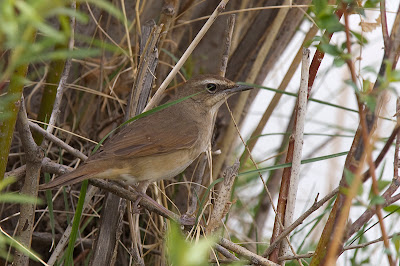Some Eastern Specialities and More - Tour 2011
Part 5: Lightning strikes twice!
What a day at the river that was. We all were very happy! Our first First for the trip was in the bag. Could this be topped? Yes!
On the next day, 23 May, when we just had finished our breakfast, some calls unknown to us could be heard coming from the willows (admittedly, no one of us is an expert on all the calls of Mongolian birds!). I got up first from the table and went to the spot. After a little search I found a phyllosc, and I immediately shouted “coronatus, a first for Mongolia!”.
Eastern Crowned Warbler Phylloscopus coronatus
First record for Mongolia
After the initial ID the bird was watched by most of us (except for Matze, who preferred to continue cleaning his camera stuff...) but could not be photographed as it ventured all too quick through the bushes and then disappeared. By sheer fluke Matze also got to see this bird (if it was the same), even better: he photographed it in the afternoon.
Eastern Crowned Warbler, Khalkhgol Valley
23 May 2011, © M. Putze
23 May 2011, © M. Putze
Monotypic species that breeds in SE Russia in Amurland & Ussuriland,
NE & C China in N & E Manchuria and in W Sichuan, S Sakhalin, Korea
and Japan; non-breeding S Myanmar E to S Laos and S to Sumatra & Java.
By this time the bird was singing its simple song not far from the first site. It was identified only later, when the pics were shown to the group. Fantastic: two Firsts for Mongolia within two days and at the very same spot and luckily both almost perfectly documented (except that we did neither record calls nor songs). We had some extra beers that evening (actually we started well before eve…).
Of course, we saw other birds at this far-eastern Mongolian river, too. Common Pheasant called frequently and there was a pair of Yellow-rumped Flycatchers above the camp.
Yellow-rumped Flycatcher, Khalkhgol Valley
May 2011, © M. Putze
May 2011, © M. Putze
An Oriental Turtle Dove was incubating its full clutch in its flimsy nest on an elm tree while we had several flocks of migrating Eurasian Siskin, all on either 22 or 23 May.
The next day, 24 May, brought us a Phylloscopus "fall in spring" (the previous night had been cloudy). This morning the bushes were full of birds. But of course not only phylloscs were present in larger numbers. Already before sunrise we heard a calling Grey Nightjar (newly arrived during the night) and in the early morning a Grey-headed Lapwing flew to the north. Best bird was probably a Pale-legged Leaf Warbler, but also Radde’s Warbler, Tristram’s Bunting, Siberian Blue Robin and Red-flanked Bluetail had arrived. The majority of the warblers were Pallas’s and Yellow-browed Warblers, though.
At noon we headed towards the north and – after having seen a beautiful adult male Pied Harrier (the only one during the entire trip!) – pitched the tents near the plantation at Khalkhgol Sum. The plantation is as run down as the village itself. The fence is broken many times and cattle browse down the remaining trees. Other trees have been cut. Still there is a warden who claims to be on duty, but seemingly he has his own idea of being on duty!
Richard’s Pipit, Khalkhgol Sum, May 2011, © A. Buchheim
Dusky Warbler, Khalkhgol Sum, May 2011, © A. Buchheim
Radde’s Warbler, Khalkhgol Sum, May 2011, © M. Putze
Pallas’s Warbler, Khalkhgol Sum, May 2011, © M. Putze
At our campsite we saw a Yellow-browed Bunting, another Yellow-throated Bunting (this time a female), several Chestnut Buntings, a male Tristram’s Bunting, a pair of Eyebrowed Thrushes, about 20 Siberian Blue Robins, a Red-flanked Bluetail, a Bluethroat and 15 Oriental Greenfinches, just to mention the rarer ones.
Male Siberian Blue Robin, 2nd calendar year
Khalkhgol Sum, May 2011, © M. Putze
Female Siberian Rubythroat, 2nd calendar year
Khalkhgol Sum, May 2011, © M. Putze
Observations were a bit hampered because a dust-storm had hit the area in the afternoon but died off until nightfall. Here as well, Grey Nightjar was singing in the night.
On 25 May the bushes at our campsite still were full of migrants (and residents). We saw our only White-vented Needletail this day and another Grey-headed Lapwing on the other side of the river. Two-barred Greenish Warbler had arrived, a Relict Gull in its nice breeding dress was seen and Matze and Uli found a pair of Yellow-throated Buntings plus a male Yellow-rumped Flycatcher one kilometre from the camp. A single Chinese Pond Heron visited a small wetland and the plantation had a singing Eurasian Collared Dove.
Male Yellow-throated Bunting, near Khalkhgol Sum
May 2011, © M. Putze
May 2011, © M. Putze
Two-barred Greenish Warbler, Khalkhgol Sum
May 2011, © M. Putze
May 2011, © M. Putze
Almost all migrants left the area over night, but we had Black-browed Reed Warbler and a male Yellow-rumped “Flyc” in the morning. On 26 May we checked the plantation before noon. This produced 4 Eurasian Collared Doves and a female Yellow-throated Bunting but no Chinese Grey Shrike was found.
2nd calendar year male Yellow-rumped Flycatcher
Khalkhgol Sum, May 2011, © M. Putze
The guys after checking the plantation
Khalkhgol Sum, May 2011, © U. Winkler
Female Yellow-throated Bunting, Khalkhgol Plantation
May 2011, © A. Buchheim
May 2011, © A. Buchheim













No comments:
Post a Comment